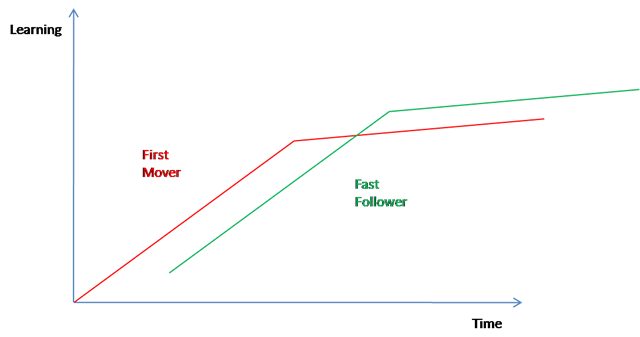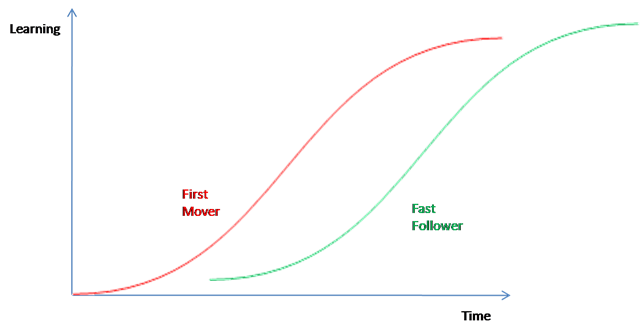[cross posted at FAST Forward blog]
How often do you run across organizations that claim they intend to be “fast followers” when it comes to some dimension of strategy and innovation? Maybe I’m simply cranky because it’s Monday, but is there any way to make sense of such an approach in operational terms? The image of “fast follower” is intended to evoke a NASCAR driver drafting behind the leader, carefully waiting for the right moment to streak past and across the finish line. It’s deeply rooted in a notion that strategic success is a function of execution.
Any fast following strategy assumes learning from the leaders as a necessary first step. If you actually believe that the strategy can work, you need to be operating with something along the lines of the following as a theory of learning over time:
In this model, watching a first mover and waiting allows you to start your learning at a higher level and sometime later pass the first mover as their learning process peaks and levels off or slows down. I have two problems with this model. First, it assumes that the lessons learned by our first mover are easily observable and quickly transferable. Second, it still denigrates learning as an ongoing requirement. In this model, learning only needs to happen long enough to figure out the new strategic game and we get back to execution as the only relevant differentiator. It encourages you to undervalue and under invest in learning as a strategic competence.
I suspect that strategic learning is much more likely to follow a logistics curve of some sort. Early learning is relatively slow, followed by a period a very rapid learning, and ultimately a leveling off. If you accept that model of learning, then a fast follower strategy becomes even more suspect. In that environment, first mover advantages are likely to be more pronounced, with something like the following representing that situation:
At this point, being early in my own learning process, I mostly have more questions, not answers. Among them, in no particular order, are:
- What’s the relative value of competitive secrecy vs. the internal organizational drag on learning imposed by attempts to preserve secrecy?
- What can you do to shorten the slow ramp stage of learning?
- Under what circumstances would fast following remain a viable strategy? Are those circumstances strategically interesting?
- How do shortening learning cycles alter this argument?


